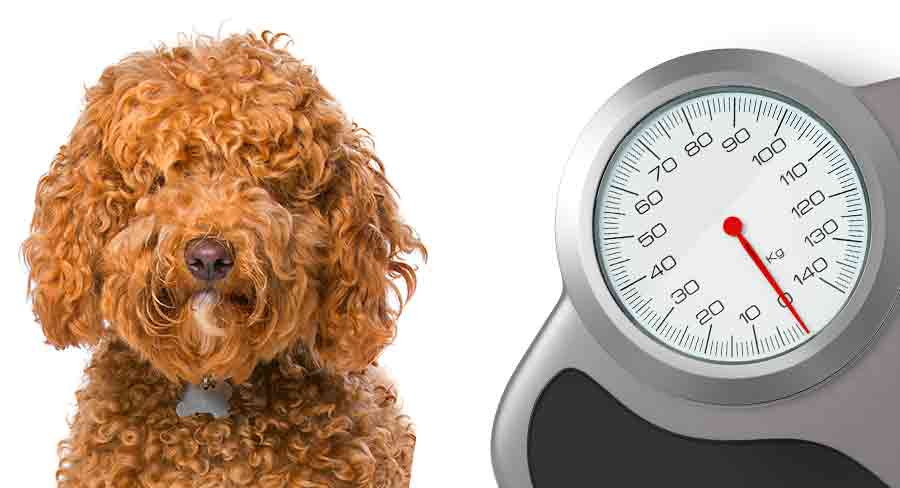Are you worried that you have a skinny Labradoodle? We take a look at the normal lower limits of Labradoodle weight, and what to do if your Labradoodle is looking too lean.
What is a normal Labradoodle size?
Does your Labradoodle weigh a lot less than your friend’s? Or are they much smaller than their siblings from the same litter? This isn’t necessarily a big deal. Let’s start by looking at some of the reasons we expect to see a lot of physical variation between Labradoodles, and why some Labradoodles naturally weigh less than others.
First generation Labradoodles
Most Labradoodles are a first generation (f1) cross between one Labrador Retriever parent and one Standard Poodle parent. Female Labrador Retrievers weigh 55 – 70 pounds, and males weigh 65 – 80 pounds. Standard Poodles are slightly smaller – females weigh 40 to 50 pounds, and males weigh 60 to 70 pounds. When it comes to size, first generation Labradoodles can weigh as much as their heaviest parent, as little as their lightest parent, or anything in between. So female f1 Labs may weigh 40 pounds or 70 pounds, and males may weigh 60 pounds or 80 pounds. Even within a litter, one girl could be close to the bottom of the Labradoodle weight range, while here sister are all near the top. And likewise, one boy could be much smaller than his brothers.

The bottom of the normal weight range for f1 Labradoodles is even lower if a Miniature Poodle is used as the sire (dad). Miniature Poodles weigh just 10 to 15 pounds, so the potential weight range of grown up Mini Labradoodles is very wide, and the potential for very small individuals is much greater.
Differences in body shape
Another way healthy Labradoodles can look very different is their build, or silhouette. Labradors are relatively stocky dogs. Their body is usually slightly longer than it is tall – like a wide rectangle – and it should be powerfully muscled. Being overly tall or ‘leggy’ is specifically discouraged by the breed standard. English Labs, also known as ‘show’ or ‘bench’ type, look particularly heavy set and may pass this build onto their puppies.
On the other hand, Poodles ought to be equal – or square – in height and length. Their breed standard describes them as elegant and smoothly muscled. So stood next to one another, Poodles tend to look taller and leaner than Labradors of the same weight. In particular, their legs look much longer and slimmer. So healthy Labradoodle can have a more slender outline than you were expecting, if they greatly take after their Poodle parent in build.
What about Australian Labradoodles?
Australian Labradoodles are an attempt to standardize the Labradoodle into a pure breed in their own right. Rather than every dog being a first generation cross, Aussie Labradoodles come from breeding lines of other Australian Labradoodles. Australian Labradoodles come in three sizes:
- Standards, which weigh 45 to 65 pounds.
- Mediums, which weigh 30 to 45 pounds.
- And Miniatures, which weigh 15 to 30 pounds.
So a healthy Labradoodle, depending on their parentage and the genes they were dealt, could weigh as little as 15 pounds, or as much as 80 pounds! It’s a staggering range, which means an individual dog’s weight in pounds isn’t usually enough information by itself to decide whether they’re too skinny or not. Which leads us to the importance of body condition.
Skinny Labradoodle Body Condition
Body condition scores are a valuable way of assessing whether a Labradoodle is a healthy weight, or too skinny. Body condition is measured looking at your dog’s outline and feeling their ribs, and comparing them to a body condition chart like this one from the World Small Animal Veterinary Association.
Dogs at an ideal weight have a visible waist when viewed from above, and the underside of their tummy slopes upwards from their rib cage towards their tail. Sometimes a Labradoodle’s dense, cuddly coat makes it a little difficult to see their outline clearly, so you can also press flat hands against their ribs. Their ribs should be easy to feel, with only a thin layer of fat covering them – similar to if you make a fist with one hand, and feel the place between your second and third knuckles (wear rings usually sit) with your other hand.
An underweight Labradoodle has no fat covering their ribs, and some of their bones might even be visible through their skin. In particular their ribs, vertebrae, and hip bones. Underweight Labradoodles can also develop an extremely pronounced waist, and even start to lose muscle mass.
How Labradoodle Body Shape Changes Over Time
It takes a Labradoodle puppy around 18 months to reach their full adult size. They will achieve most of their adult height by their first birthday, but as they go through adolescence, it’s quite normal for dogs to go through a ‘gangly teenage phase’. During this time, it may seem like your Labradoodle just cannot put on weight as quickly as they are growing! They might appear rather skinny, even though they’re still bursting with energy and enjoying the new found confidence that maturity brings. Usually, these dogs will start to ‘fill out’ and put on muscle after their first birthday. And by the time they are two, their weight and overall look is likely to have been steady for several months.
Your Labradoodle’s body shape might also change and get thinner again as they start to enter their senior years. This is partly due to loss of muscle mass as they get older. They might also be eating less – because they have lower energy demands, or because old-age problems like tooth decay make it harder to eat.
Is My Labradoodle Too Skinny?
Sometimes a Labradoodle’s weight (or lack of weight) can be an indicator of a more serious underlying health problem. If you’re concerned that your Labradoodle weighs too little, the best thing to do is arrange a consultation with their veterinarian. They will assess your dog’s weight and body condition, and confirm whether they are underweight or not. If they are underweight, they will help you work out the reason why. Very active or working dogs might simply need more calories. But, sometimes being underweight is a symptom of an underlying health problem. Some examples are:
- Problems with the digestive system
- Internal parasites
- Dental disease
- Liver disease
- Kidney disease
- Pancreatitis
- Diabetes
- Cancer
If you have other dogs at home, it’s also worth ruling out the possibility that one of them has snaffled your skinny Labradoodle’s meals!
How To Help A Skinny Labradoodle Gain Weight
Before taking any steps to make your Labradoodle gain weight, it’s important to consult with their veterinarian. Firstly, to confirm that they definitely do need to gain weight. Studies have shown that we dog owners are prone to misjudging our dogs’ condition, and concluding that they are more lean than they actually are! If a dog is already a healthy size, and we make the mistake of thinking they need to gain a few pounds, those pounds can have significant long term consequences for their health, including an increased risk of heart disease, hip dysplasia and premature death.
Secondly, a veterinarian should always approve and oversee any changes in your dog’s diet. Overfeeding a skinny Labradoodle too much can cause digestive upset including diarrhea. Feeding the wrong kind of diet can make underlying health problems worse too. For example, if a dog is losing weight due to pancreatitis, then tempting them with high-fat snacks will make the problem worse. You veterinarian can help you plan slow and safe weight gain, and also prescribe any additional treatment for underlying health problems.
Skinny Labradoodle Summary
Hopefully if you’ve been asking ‘is my Labradoodle too skinny?’ this article has helped you with the answer. There is a lot of natural variation in size and build among Labradoodles. So one Labradoodle at a healthy weight may look skinny next to another. Asking a vet to help you assess their body condition is the best way to make sure they’re within a healthy weight range. Any attempt to help a skinny Labradoodle gain weight should also be done under veterinary supervision.
Do you have a skinny Labradoodle?
Are they naturally slim build, or are they perhaps going the lanky teenager phase? Or was their size the first sign you had that something was wrong? Tell us your story in the comments box down below.
If you enjoyed this article, you might also like:
- Labradoodle Size and Weight
- Labradoodle Puppy Growth
- How Much Exercise Does A Labradoodle Puppy Need?
- How To Exercise Your Labradoodle
- Australian Vs American Labradoodle
- Fat Labradoodle
References
Body Condition Score. WSAVA Global Nutrition Committee. 2013.
Courcier et al. A cross sectional study of the prevalence and risk factors for owner misperception of canine body shape in first opinion practice in Glasgow. Preventative Veterinary Medicine. 2011.
Official Standard of the Labrador Retriever. American Kennel Club. 1994.
Official Standard of the Poodle. American Kennel Club. 1984.

